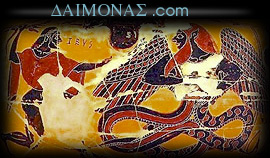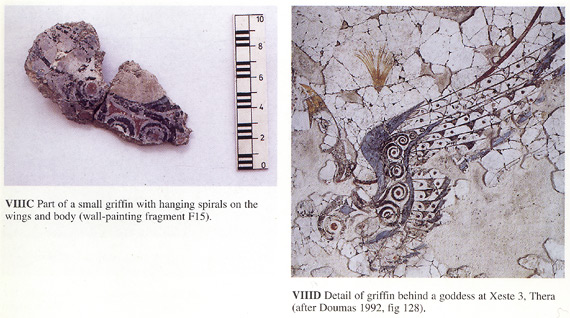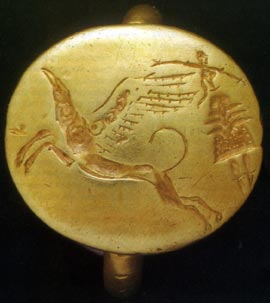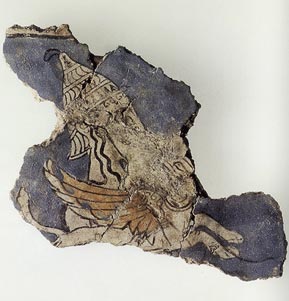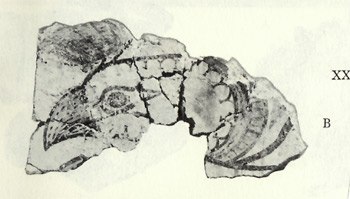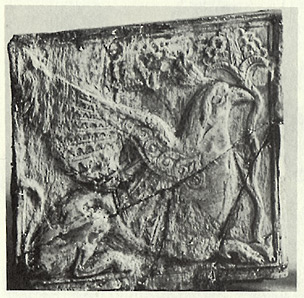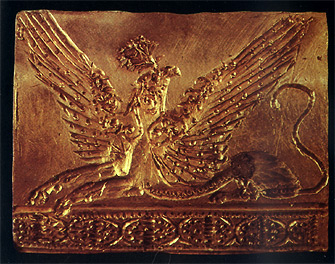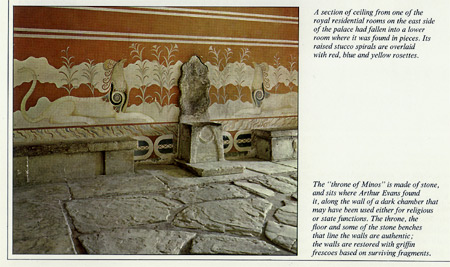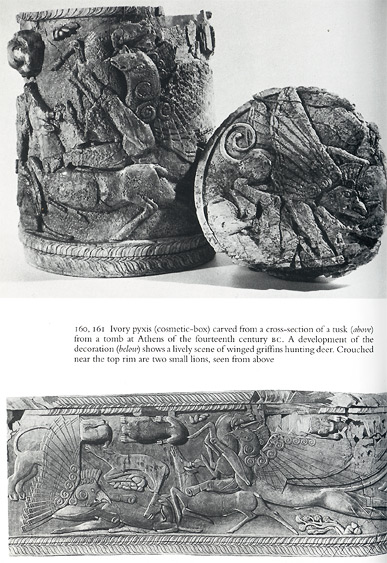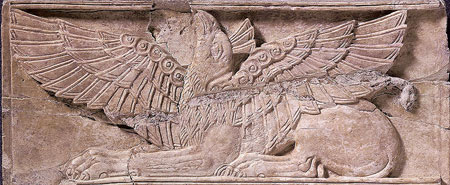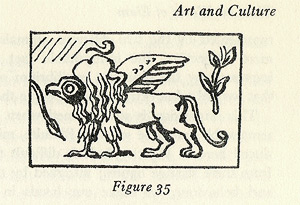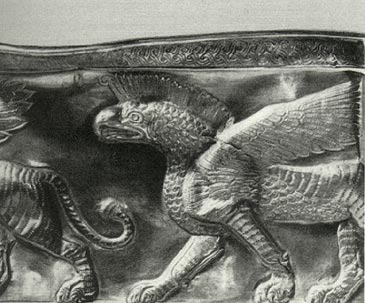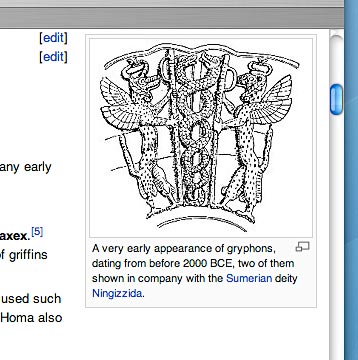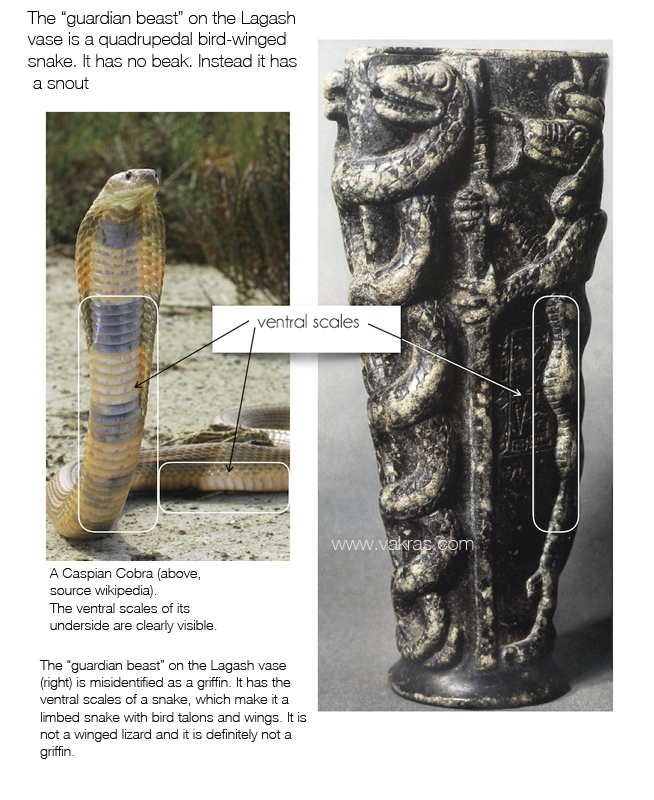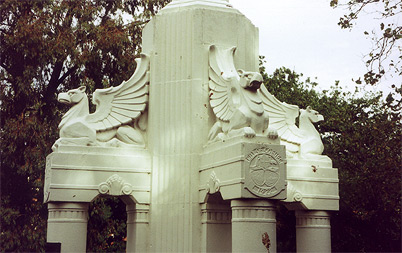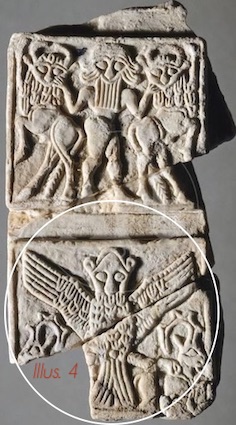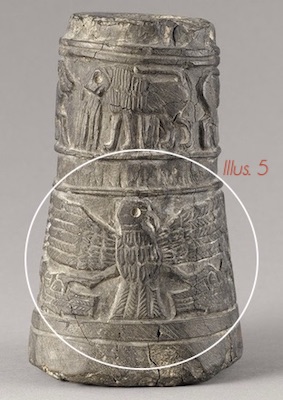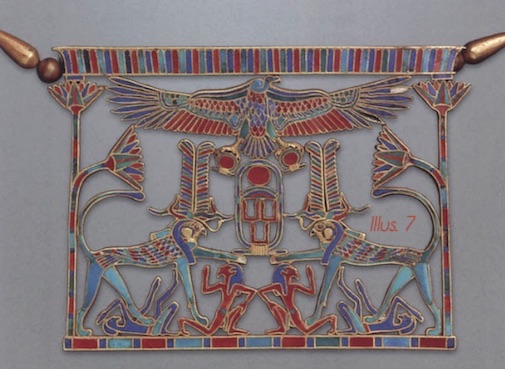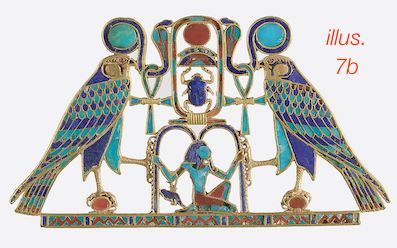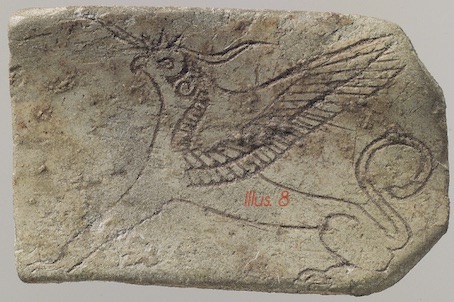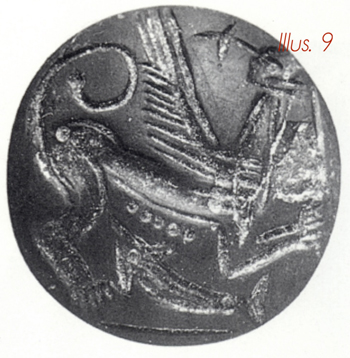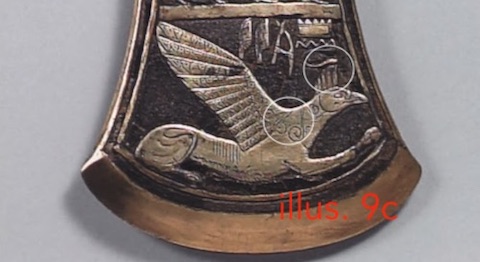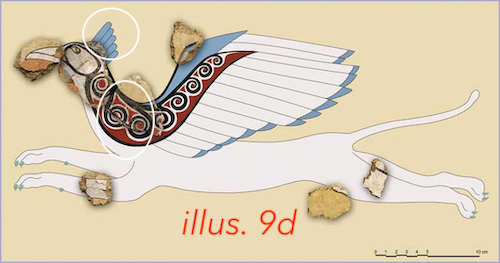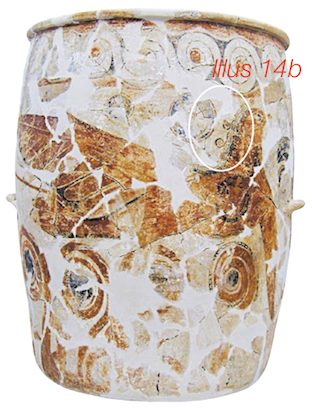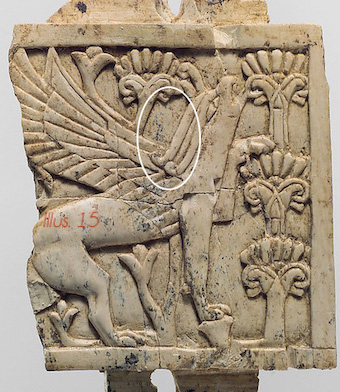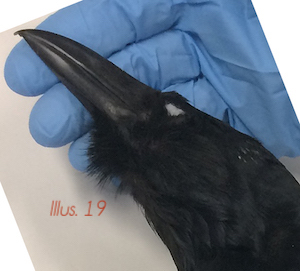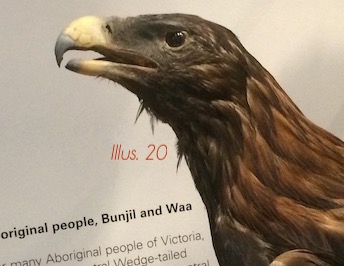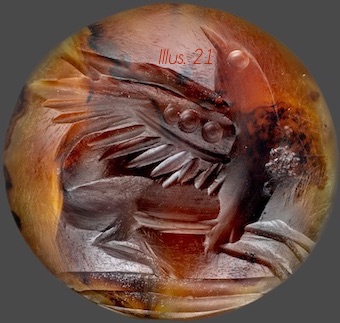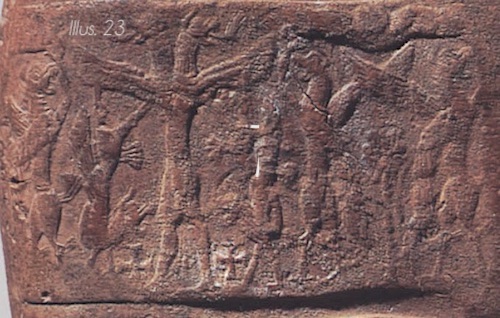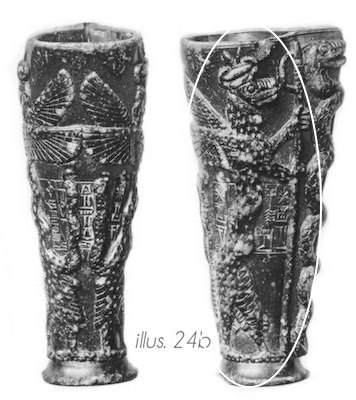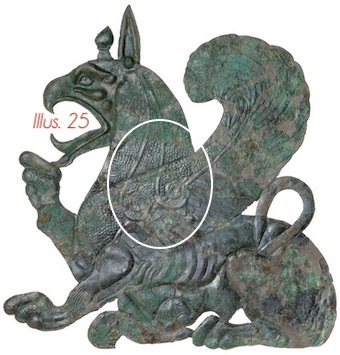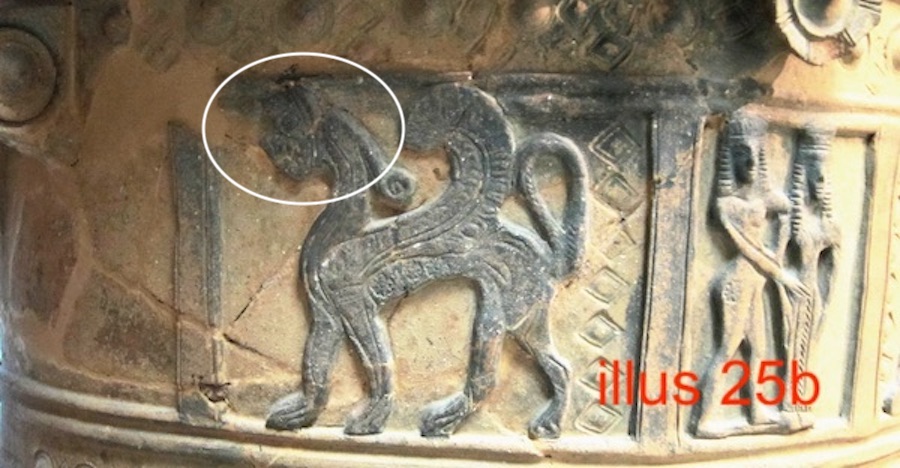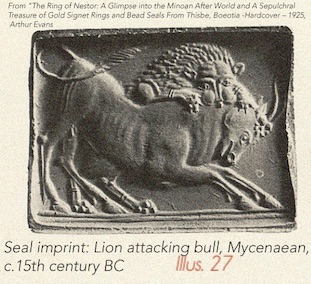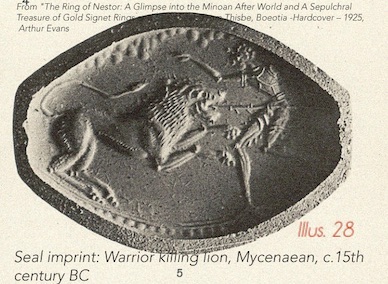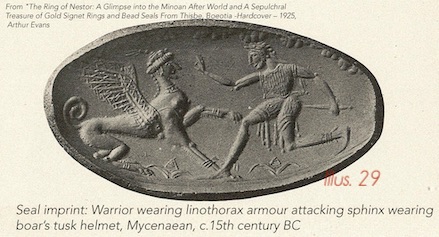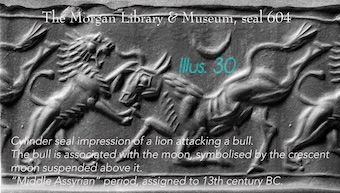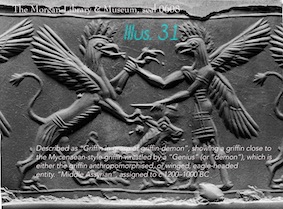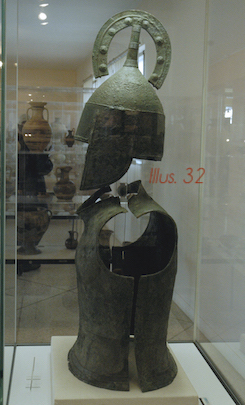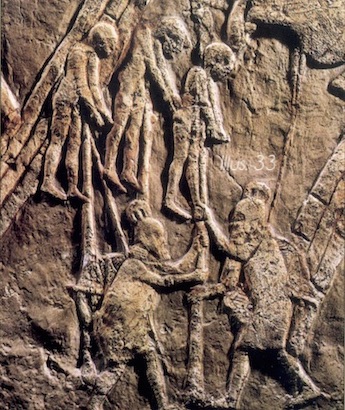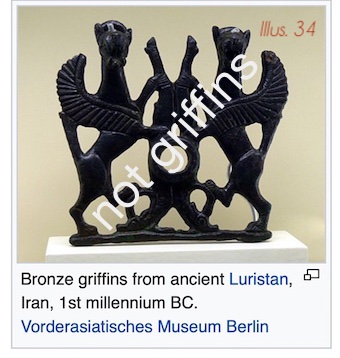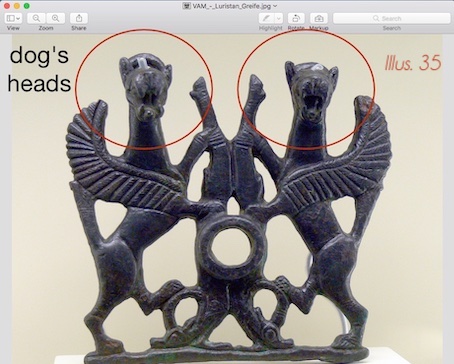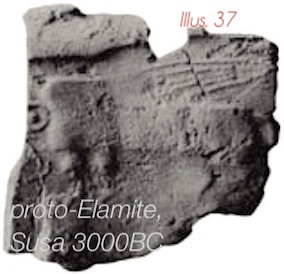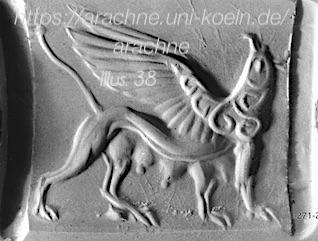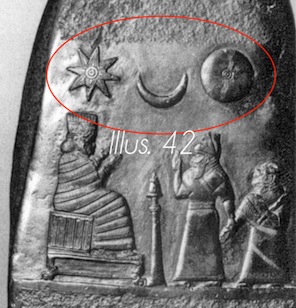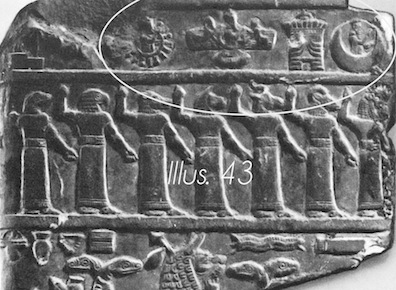AFTERWORD 2020
My griffin page which was first posted in September 2006 intended to rebut misinformation regarding the origin of the griffin that was available on the internet. This included, but was not limited to, the Wikipedia. Notwithstanding that the depiction of griffins were de rigueur in the Aegean (Greece) from the 18th century BC, or earlier, online sources instead propounded baseless "alternate facts".
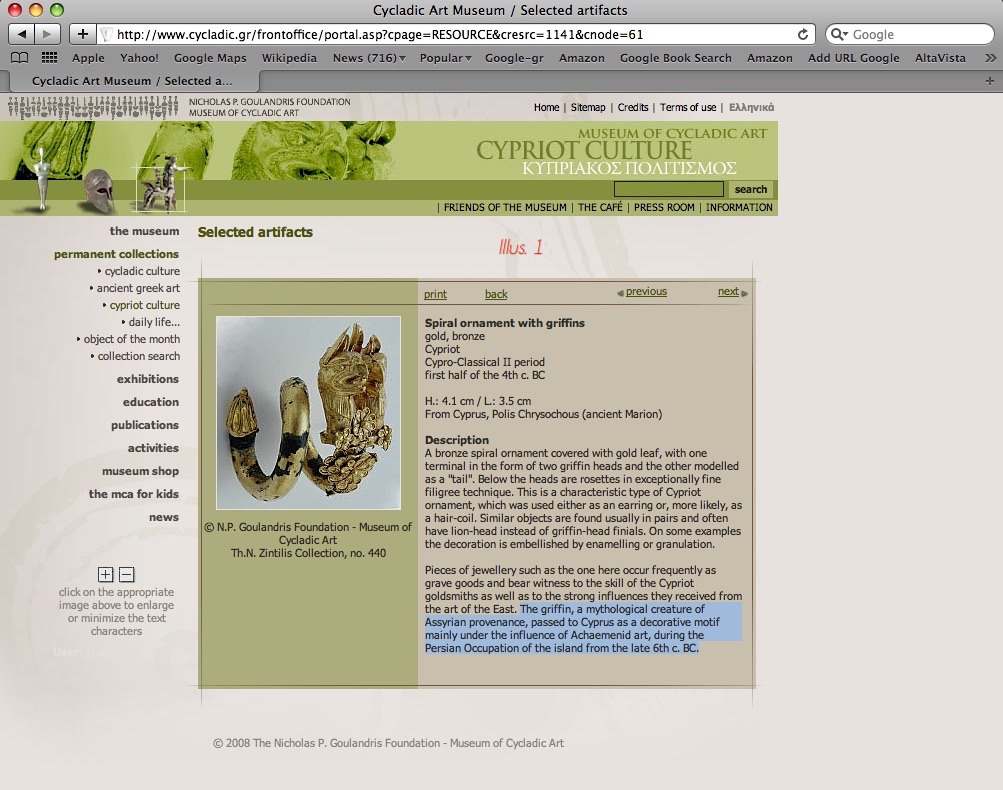
| Above, screenshot (detail) from 2009 of one of the many sites proclaiming the Near Eastern origin of the griffin. This page from a Greek (private) museum captures the height of silliness. It proclaimed the griffin to be Assyrian and that it was passed on to Greeks from Cyprus during its occupation by Persians notwithstanding that griffins had been depicted in Greece well over 1000 years earlier. Below, screenshot (detail) from 2008 of the Greek-language Wikipedia page. It proclaims, without evidence, that “the myth” of the griffin is “Mesopotamian”. There are no mesopotamian myths about griffins and the page provided no sources to support its claim. This page has since been expanded and provides considerably more unsourced disinformation. It is arguably the worst Wikipedia page on the griffin. |
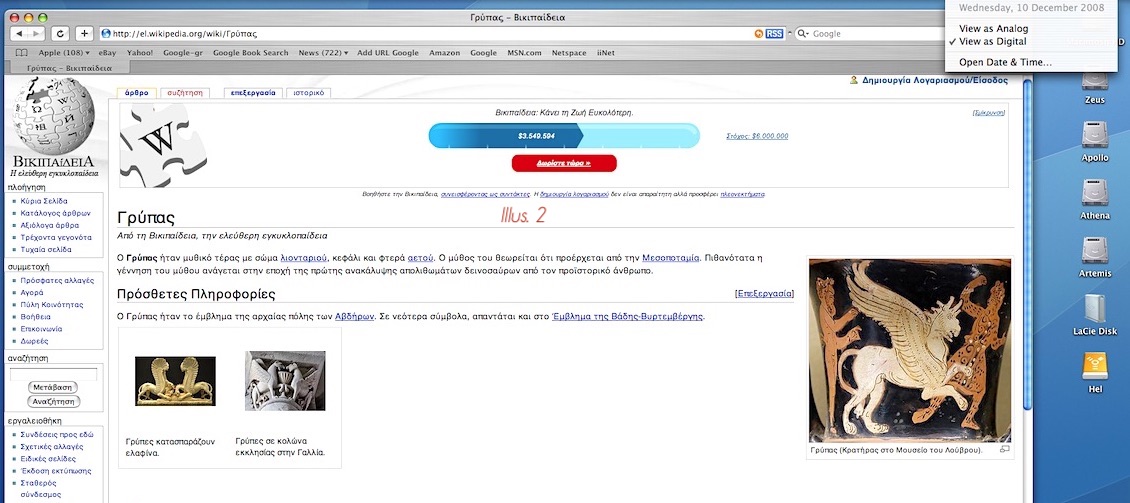
My page garnered interest. Some readers emailed objections. Other readers, to my amazement, plagiarised the page, presenting it as if it was their own; pilfered elements; and “mirrored” it in their blog which seeks “sponsorship” (payment) for providing what I have already provided.
Since this page was posted in 2006, additional material that I had been unaware of calls into question some elements that appear on it. I will summarise some of the material that would need to be considered in any future re-write, though the fundamental premise of my page remains intact: the griffin that has come down to us is Greek and arose in the Aegean. This is despite the earliest representations of composites that can be called griffins being Elamite (along with their proto-griffin predecessors from Uruk). These “griffins”, which have been given a date of around 3000 BC, disappear however. Around a millennium later “griffins” “re” appear.
The Proto-Elamite griffin, dated to ca. 3000 BC, was (is) featured on my page as a line-drawing taken from Walther Hinz’s book (for which Hinz had provided no date and which I had argued — wrongly, on the limited information available — was likely a much later piece).

| Above, Proto-Elamite seals. From the thesis published online by the University of Sydney, The Elamite Cylinder Seal Corpus, c.3500 – 1000 BC, Volume II, the Catalogue, Part I. K. J. Roach, Doctor of Philosophy, (Near Eastern) Archaeology 2008. The University of Sydney. |
The proposition of an Elamite origin for the griffin, however, runs into the problem of the absence of any line of transmission. The Elamite representations of griffins are separated by a millennium as well as geography, when they “re” appear in the Aegean in the early 2nd millennium BC. Of course griffins could have survived in some imaginary Jungian ether, ready for future generations to tap into … (!) In the intervening period, when griffins were absent in the Near East, composites such as the lion-headed eagle, Anzu, were depicted.
| Above left, gypsum and limestone slab fragment showing Anzu, the lion-headed eagle, with Ibex, ca. 2645-2460 BC from Mari, Syria, National Museum, Damascus, Syria (Image source: https://www.art.com). Above right, Bitumen with relief of eagle from (Elamite) Susa, Louvre (https://www.louvre.fr/en/oeuvre-notices/base-ritual-offering-carved-animals). In Elam the griffin disappeared and was replaced by a stylised eagle posed in the manner of Anzu. |
HORUS IS NOT A GRIFFIN
My page made no reference to what are often misleadingly referred to as “Egyptian griffins” - for good reason. Notwithstanding a stylised griffin-like composite beast appearing on the predynastic “Two Dog Pallet” (that appears to ultimately derive from Uruk?), Egyptian composite beasts disappear, only for them to suddenly re-appear out of nowhere during the Middle Kingdom. What are claimed to be griffins that make their appearance in the Middle Kingdom, are instead variations of Horus depicted as a Hieracosphinx. There are claims that a Hieracosphinx is a griffin and that it is the inspiration for near-contemporaneous Aegean griffins. This is a difficult proposition to reconcile. Why would a civilisation in the Aegean be sufficiently impressed with Horus to adopt him, but then only as a Hieracosphinx, and represent him not as a falcon, but as a raven (refer Illus. 18 & 19)? and never represent him as a composite human-falcon? never show him as the vanquisher of enemies? but instead show him as a domesticated griffin-companion to a goddess? and never adopt Seth or the Set-animal or other Egyptian entities that are usually associated in the representations of Horus (refer Illus. 40)?
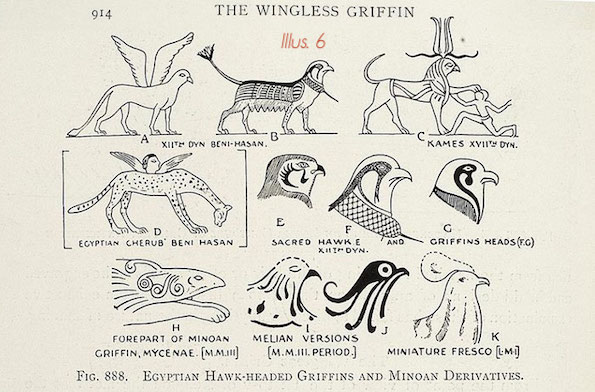
| Above line-drawings from Arthur Evans’ “The Palace of Minos: a comparative account of the successive stages of the early Cretan civilization as illustrated by the discoveries at Knossos (Band 4,2): Camp-stool Fresco, long-robed priests and beneficent genii […]” — London, 1935, Page: 914. http://digi.ub.uni-heidelberg.de In the height of silliness, Evans referred to a winged head rising out of the back of a serval as a “Cherub”. Though it is not a griffin there are persistent misrepresentations of these Egyptian renditions as being griffins (which I address in the section below, THE PROBLEM WITH ACADEMIA). |
| Above left, Horus as a Hieracosphinx wearing the two feathers crown; Nemes headdress; cow horns; kudu horns; and with a cobra. Egyptian Museum, Cairo JE 30875. Beyond Babylon: Art, Trade, and Diplomacy in the Second Millennium B.C., ISBN-13: 978-0300141436. These are not griffins. Above right, pectoral necklace ca. 1887–1878 BC (https://www.metmuseum.org/art/collection/search/544232) with confronted Falcons (Ra).
Below left, furniture plaque now at the Met Museum NYC featuring a griffin-like Horus Hieracosphinx with wings, wearing a (reduced) Nemes headdress, with kudu horns and a “crown”. Assigned to the 18th C. BC, it is claimed by the Met Museum to be the progenitor of Aegean griffins: “Griffins of this type, with a spiral curl hanging down the neck and extended wings, are characteristic of Aegean art in later periods” (https://www.metmuseum.org/art/collection/search/323574). Except that this “griffin” is Horus as a Hieracosphinx. This is not the progenitor of Aegean griffins which mainly featured raven beaks. Raised wings are not featured in Egypt, where the wings are folded down — meaning that the artisan in this piece modified a hieracsphinx for an audience familiar with Aegean griffins by giving it wings. This “griffin” is posed as is the hieracosphinx Horus (who confronts the Seth animal, refer Illus. 40). Below centre, griffin depicted on a seal–stone discovered at Akrotiri, Thera, suckling a dolphin. This griffin is Late Cycladic and assigned to ca. 18th century BC, Illus. 66, Christos Doumas, Thera, Pompeii of the Ancient Aegean. This griffin is contemporaneous with the furniture plaque that is claimed inspired it. Below right, seal imprint of two griffins with collars also from Akrotiri that dates to between 1750 - 1650 BC which is also roughly contemporaneous with the “trading colony” piece claimed to have inspired it.
|
|
|
|
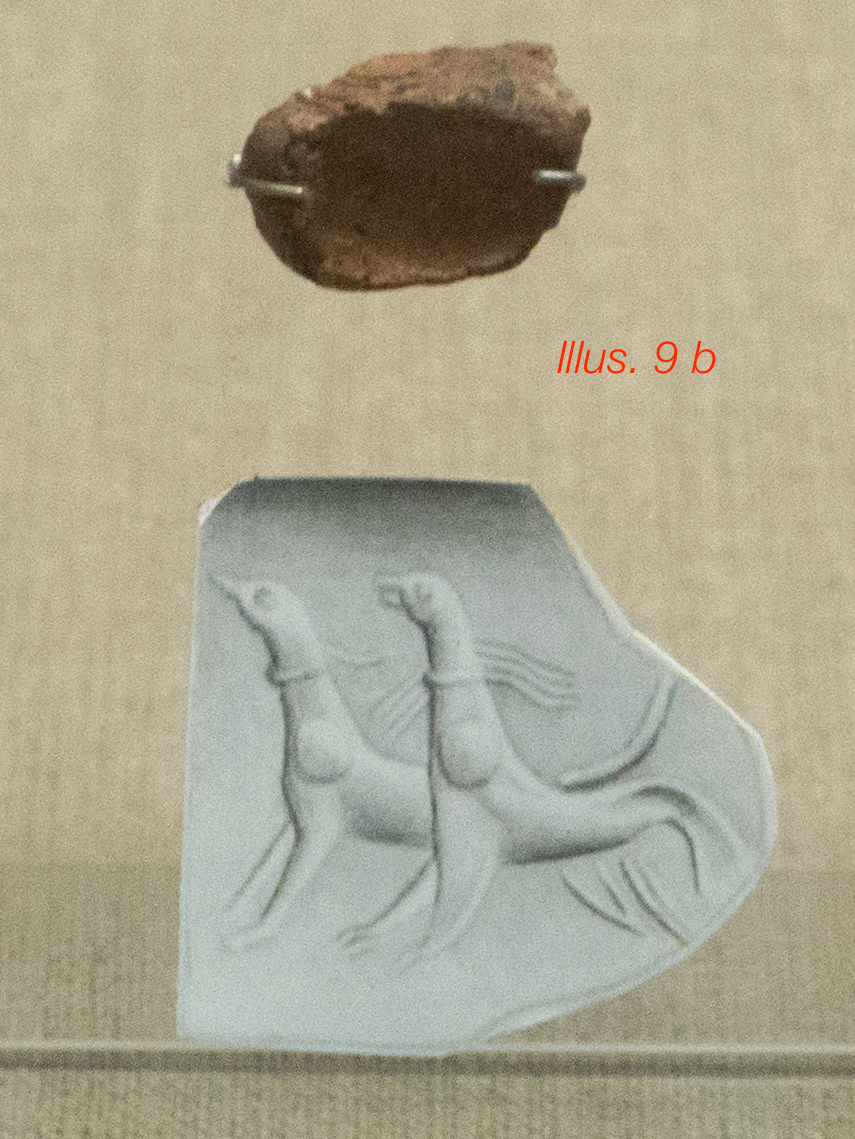 |
DUBIOUS CHRONOLOGY: ARCHAEOLOGISTS VS SCIENCE
The chronologies assigned to the Near East and Egypt are problematic and have been upended since the eruption dates of two volcanoes — the Santorini (Thera) volcano, and Hekla, located in Iceland — became firmly established. The dates originally given for the eruptions of both volcanoes were based on the conjecture of archaeologists.
The Thera eruption had been assumed to have occurred at ca. 1500 BC. That date is now known to be wrong and the eruption is now placed in the mid to late 17th century BC. This dating means that “Minoan” objects from Thera are older than they have previously been assumed to be.
Conversely, the reign of Ahmose i should be dated earlier than it had previously been dated as a growing consensus associates his reign — via the “Tempest Stele” — with the eruption at Thera — http://www.sci-news.com/othersciences/linguistics/science-tempest-stela-ahmose-worlds-oldest-weather-report-01826.html https://www.biblicalarchaeology.org/daily/news/reinterpreting-the-tempest-stela
Hekla’s eruption date which had long been believed to have occurred at ca. 1150 BC had been calculated on the assumed lengths of dynasties and reigns of Egypt's pharaohs. It has now been dated to ca. 929 BC \ 950 BC (re: illus. 11 & 12) using various dating techniques. The corrected date means that the “Sea People” invasion of Egypt happened much later; that the collapse of Mycenaean palace civilisation occurred at ca. 900 BC or later (not ca. 1100 BC); that the Greek “Dark Ages” never occurred, which in turn means there was no break in Greece with Mycenaean civilization and no period of “Orientalisation” during which the “Orient” is claimed to have re-introduced into Greece what Greeks “lost” when Mycenaean civilisation collapsed — such as the griffin. These “Dark Ages”, which have been claimed to lie between the years of ca. 1100 BC to 800 BC, are exposed to be an interpolation — a contrivance made necessary by a gap that only came into existence because of archaeologists’ faulty chronologies. If it can be likened to anything, the Greek “Dark Ages” are the epicycles on epicycles of Ptolemaic astronomy created to square the observations of the heavens with calculations made on the a priori assumption that earth was the centre of the universe. Archaeology has sought to make the evidence match a priori assumptions that gave rise to faulty chronology.
Notwithstanding the evidence, though not unsurprisingly, Egyptologists and Aegeanists refuse to correct their chronologies.
When, for example, archaeologists are disposed to accept Josephus’ etymology for “Hyksos”, and on that basis claim Levantines ruled Avaris even though the “Minoan” frescoes of bull-leaping and griffins show the Hyksos royalty to be Aegean; believe that Moses actually existed and led Jews out of Egypt; and refuse to countenance the fact that the Biblical Moses who as an infant floated in a basket down the Nile is appropriated from the fable of the infant Sargon floating in a basket down the Euphrates; etc., it becomes clear that archaeology is hardly guided by empiricism. The a priori starting point of archaeologists, based as it is on the Bible, holds the Hyksos to be Jews, or that they are at least Canaanite precursors of Jews, and that they, led by Moses, were expelled by Ahmose i … notwithstanding that if the Jews were Hyksos, they would not, as the Bible claims, have encountered Philistines in Canaan at the time of Ahmose i — because Philistines were not yet there. Philistines, the Sea Peoples, arrived around 800 later. The Hyksos elite, it is clear, was Aegean, not Canaanite, not Jewish, and the name Moses is a corruption of Ahmose i, an Egyptian liberator and not a Jew. The entire Biblical absurdity strains credulity.
That there are Syrian and Levantine finds at Hyksos Avaris does not give credence to a proposition of the Hyksos being Canaanite — the Canaanite regions from which the Hyksos are proposed to have originated, it should be noted, have, as did Avaris, palaces decorated with Aegean frescoes painted in the Aegean manner (on wet plaster) with Aegean themes. Qatna’s Royal Palace in Syria, and Alalakh, also in Syria, demonstrate an Aegean presence which is otherwise unattested in the written sources. It is hardly a coincidence either that the Hurrian Mitanni, though attested to in the written sources, are hardly visible outside those sources.
As in Egypt, the Hyksos in Syria/Canaan were apart from those they governed. The Canaanite subjects of the Hyksos in Syria settled in Hyksos Avaris.
The Aegean Hyksos introduced the griffin into Egypt. The griffin on the axe blade of Ahmose i (illus. 9c) is the same griffin as was found depicted in Hyksos frescoes in Avaris (illus. 9d), which itself is prefigured by earlier Aegean griffins which include the crest and heart shaped pattern which are all features of Aegean griffins (illus. 9e).
| Above left, Ahmose i’s ceremonial axe with an Aegean griffin (Beyond Babylon- Art, Trade, and Diplomacy in the Second Millennium B.C.) . Above right, Reconstruction of Hyksos Avaris griffin in flying gallop pose on Manfred Bietak’s page entitled “The Palatial Precinct at the Nile Branch (Area H)”. Below, “Griffin Sword discovered at the Fetish Shrine at Knossos”. Recumbent griffin depicted on a dagger of the type found at Akrotiri, Thera, and Mycenae’s shaft graves (image from Met Museum online). |
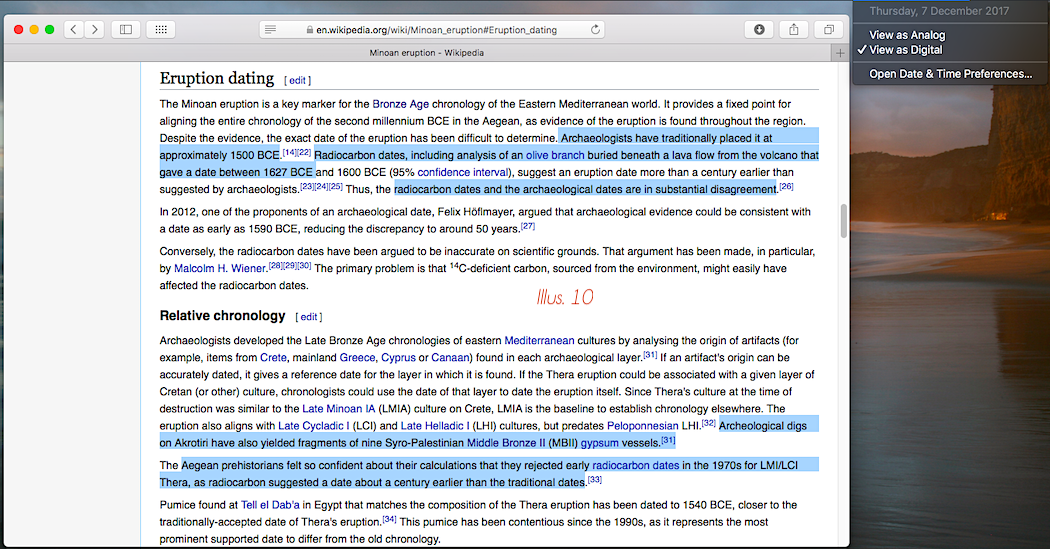
| Above, screenshot. Dating the Thera eruption. Though radiocarbon dates were known since the 1970s archaeologists refused to allow facts to alter their conclusions. (Note the presence of Middle Bronze Age II Syrian artefacts found at Thera. The duration of the MBA II was from ca. 2000-1750BC). Below, screenshot. Hekla eruption is dated to 950 BC. |
 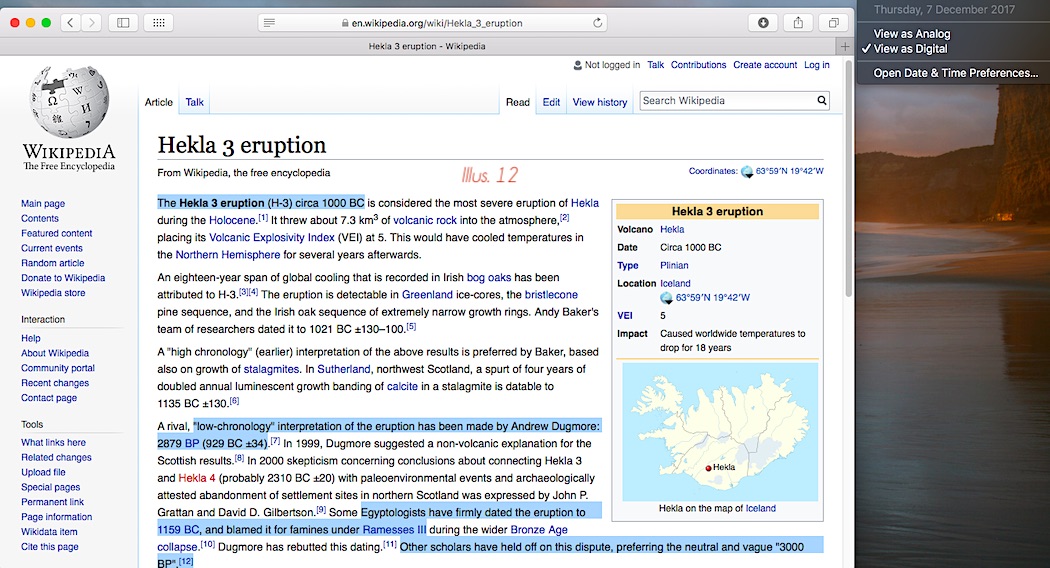
| Above, screenshot. Archaeologists ignore science, leaving their Egyptian chronologies undisturbed - proving that archaeology is not evidence based but an emotional attempt to reconstruct the past according to preconceptions. Below, (earlier, 2010) screenshot. Hekla dated to ca. 1156\1155 BC: “no Egyptologist dates Rameses III’s reign to as late as 1000 BC.” |
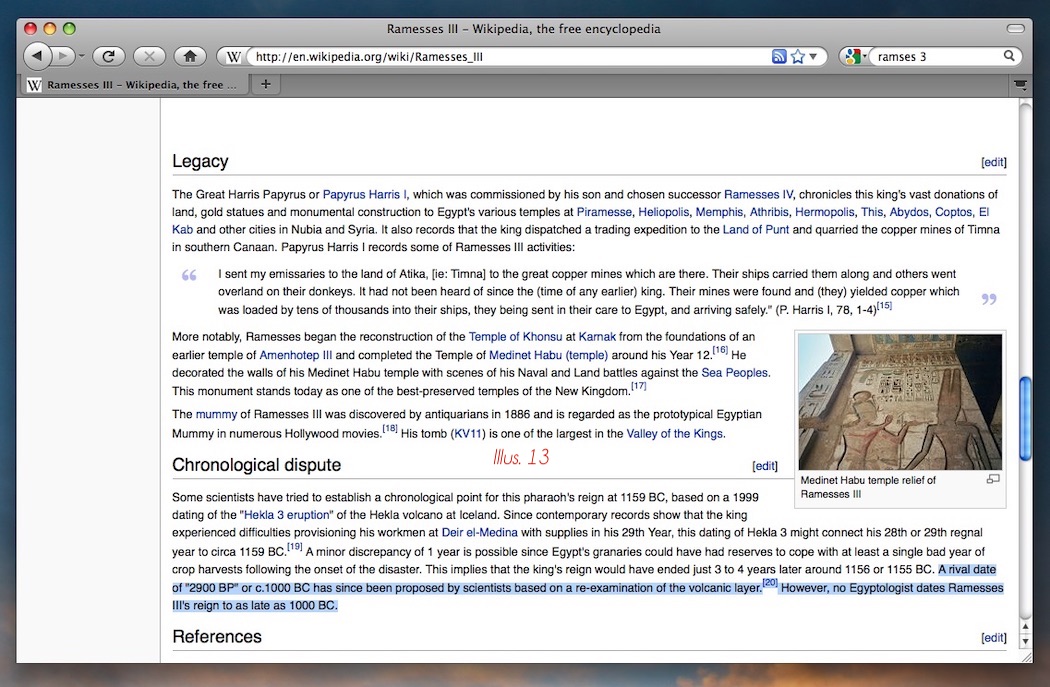
A PARALLEL TO THE GREEK GRIFFIN
An assumption I once shared with archaeologists was that the Minoan and Aegean/Mycenaean griffins were the same and that they are interchangeable. That turns out to be wrong— the griffin of Thera and griffin of Krete (“Crete”) are not the same. The Knossos throne room griffin which was featured on my original page is a Minoan griffin from Krete and it is rendered with characteristics that distinguish it from the Aegean griffin from Thera. The Minoan griffin became part of the inheritance of the Phoenicians, who infused it with Egyptian elements. The assumption of Aegeanists is that Thera was a “Minoan” (ie, Kretan) colony. It is not. What is found in Thera is the precursor to what has been termed “Mycenaean”.
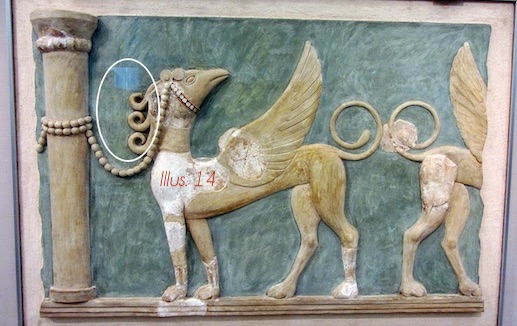 |
|
|
| Above left, griffin tethered to pillar, Knossos, Heraklion Archaeological Museum - Griffins Fresco with high-relief from the "Great East Hall" of the palace of Knossos. Neopalatial period (1600-1450 BC). Above centre, griffin depicted on a pithos from Akrotiri, Thera, depicting a maned griffin of the type that appears in Krete. Middle Cycladic ca. 18th century BC., www.academia.edu . Above right, Furniture plaque from Nimrud which is described as “Neo-Assyrian” (notwithstanding many “Neo-Assyrian” objects being loot amassed from the committing of mass slaughter and genocide). Image, Met Museum, Image source: https://www.metmuseum.org/art/collection/search/325668 . Note the external spiral “mane” which is shared by both the Phoenician and Kretan griffins. This is not a feature of the Aegean/Mycenaean/Greek griffin, in which the spirals were internal to the design and ran along the wing humerus. |
DEFINING THE GRIFFIN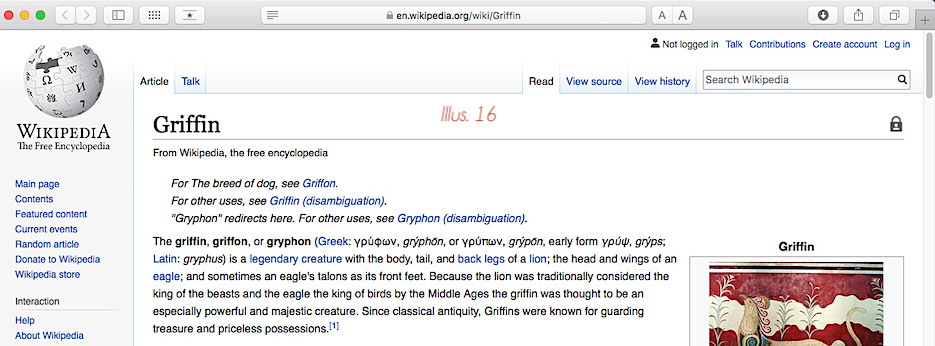
The griffin is defined in the Wikipedia (current at the time of writing, 2020) as “a legendary creature with the body, tail, and back legs of a lion; the head and wings of an eagle; and sometimes an eagle's talons as its front feet”. The Wikipedia adds, “the lion was traditionally considered king of the beasts and the eagle the king of birds”. The Elamite griffin fits Wikipedia description—the griffins that appeared in the Aegean a millennium after the Elamite griffin had disappeared, do not.
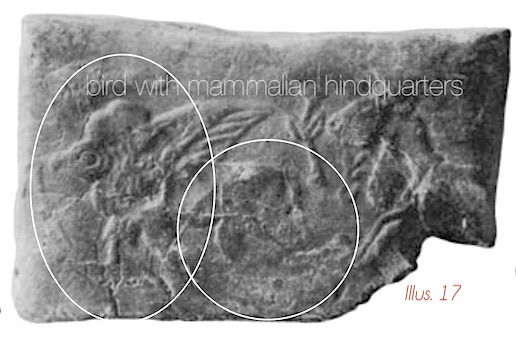
THE AEGEAN DOG-RAVEN: THE GRIFFIN
The Aegean/Mycenaean griffin unlike the Elamite griffin is composed of a raven’s head (evinced by its beak) and a canid torso. In contrast, the Elamite griffin is a bird of prey with its tail replaced by (most likely) feline hindquarters. That the Mycenaean griffin is a canid, rather than a feline, is clearly evinced by its claws which remain unretracted, even when it is at rest. Though a griffin, it does not satisfy the Wikipedia definition because its avian component is not that of a raptor (eagle), and its mammalian component is not that of a lion. It does not symbolise the “king of beasts” or “king of birds”. However, this is the griffin which gave rise to the griffin of Classical Greece. It is a dog/raven composite (though its tufted tail could indicate an additional element?). By virtue of its compositional elements and the symbolism conveyed by them, it is unrelated to Elamite griffins. The Aegean griffins are not a symbol of a sky and land “king”, but are a divine demon-protector avatar. (Note: a number of other Mycenaean-period griffins have what might be pigeon/dove beaks; others have the beak of a nightingale; the small gold griffins from Grave iii -Grave Circle A- are eagles. This indicates that there were different griffins, each conveying a different symbolism, much like later Greek gods’ associations were with birds — ie., Athena’s owl, Aphrodite’s dove, Apollon’s crow.)
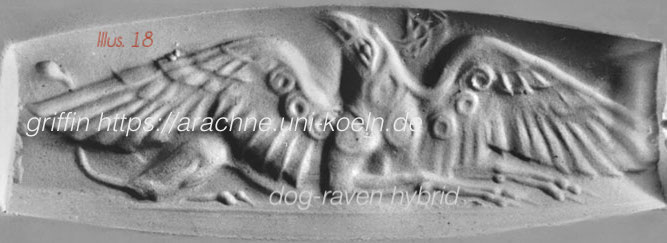 |
|
|
| Above left, Griffin - Seal impression after CMS I 271. Found at Myrsinochori, Messinia. National Archaeological Museum Athens.Image source: https://arachne.uni-koeln.de/arachne/index.php Note, unlike the Kretan griffin the Aegean/Mycenaean griffin does not have a “mane” - its spirals are internal. These spirals remain internal even in the Classical Greek griffin. Mycenaean griffins often sprout a vegetal growth from their head, while in the above example, it has a raven beak (comparable to the Thera-fresco griffin) and straight claws that remain unretracted while it is at rest, a feature of canids. Above centre, photograph (by Lee-Anne Raymond), detail of raven beak, Melbourne Museum. Above right, my photo of Australian wedge-tailed eagle, Melbourne Museum. |
|
|
| Left, Mycenaean-period griffin from the Griffin Warrior tomb at Pylos (http://www.griffinwarrior.org). The griffin has the head and beak of (most-likely?) a nightingale. It is definitely not the beak of a raptor. |
|
WHEN ANZU MET ΓΡΥΨ — A NEAR EASTER GRIFFIN-LIKE PARALLEL
The parallel mesopotamian tradition of a griffin-like monster - which is not a griffin - was the bipedal Anzu. In the mid-second millennium BC Anzu was re-imagined. What had, throughout the third millennium BC, been a lion-headed eagle suddenly became a ferocious taloned and winged quadruped. Anzu remained a ferocious quadruped in neo-Assyrian representations. The elements seen in the quadrupedal Anzu owe a considerable debt to the twin-winged-limbed-snake with talons featured in the Girsu Gudea libation vase from Lagash (illus. 24b) — which is assigned to ca. 22nd C. BC — which the Wikipedia had previously presented as a “gryphon” in the early 2000s.
The ferocity of the quadrupedal Anzu came to cast an influence on the Mycenaean griffin when it was transformed from its Mycenaean version into the familiar Classical Greek version some time in the early 1st millennium BC.
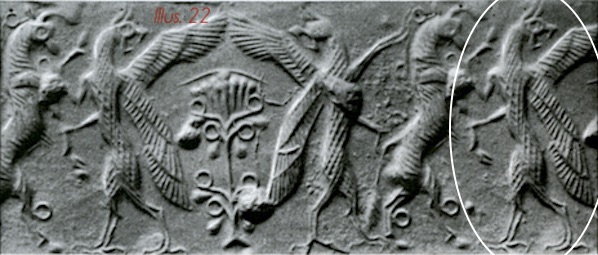 |
|
Above left, Cylinder seal impression showing ‘ferocious guards” of stylised world tree, described as "monsters in combat…from the Mitanni tradition” (p. 441, Amiet). Cylinder seal assigned to the 13C. BC.
Illus. fig. 803. Louvre. Pierre Amiet, Art of the Ancient Near East, ISBN 0810906384 . Above right, detail of Assyrian contract with cylinder seal impression of Eriba-Adad I featuring a double headed Anzu monster. Ashur, Middle Assyrian, c. 1390-1364BC. Staatliche Museen zu Berlin, Vorderasiatsches Museum VAT9009. P. 210 “Beyond Babylon: Art, Trade, and Diplomacy in the Second Millennium B.C.”
Below left, Assyria relief “, Gypsum wall panel relief: showing showing the god Ninurta…, chief god of the city of Nimrud [with] a thunderbolt in each hand; he pursues the monster Anzu. Ashurnasirpal I, Neo-Assyrian, 865BC-860BC”. British Museum. This Assyrian Anzu stands on bird-taloned feet, while his hands are taloned human hands. Below right, the guard in the Girsu Gudea libation vase (https://commons.wikimedia.org/wiki/File:Girsu_Gudea_libation_vase.jpg) which pre-figures the quadrupedal Anzu.
|
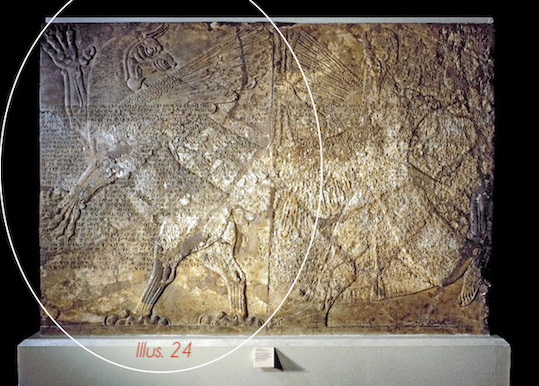 |
|
AEGEAN GRIFFIN RE-IMAGINED
For centuries the Aegean\Mycenaean griffin and the Assyrian Anzu had remained seperate and distinct entities. Anzu cast no influence on the depiction of the Mycenaean Greek griffin. However, during the post-Mycenaean period, the Greek griffin gained the ears of the quadrupedal Anzu monster along with its ferocity. Its now open beak matches Assyrian models in which Anzu snarls with an open mouth and bared incisors. The Classical Greek griffin did however retain its Mycenaean spirals which were internal (to its design).
| Above left, Cut out embossed bronze sheet showing female griffin nursing her young, assigned to a Corinthian workshop at c. 630-620BC. Image source (e-puplication available online http://www.olympia-greece.org/m-ebook.html), p. 81 "The Archaeological Museum of Olympia", ISBN 9789608933941, Authors Giorgos Fafalis, Såokratåes Maurommatåes, Georgia E. Hatzi. The Classical Greek griffin was altered from a raven (or nightingale) to an eagle. It retained the internal spirals of its Aegean ancestors (circled). It remained distinct from the Phoenician griffin which had the spiral mane of the griffins from Krete. Somehow it gained what is often referred to as a pommel growing on its forehead. Above right, an intermediate “archaic” Greek snarling “griffin” with features of the quadrupedal Anzu. It features a non-avian head with a row of fangs. Assigned to 675 BC, it is likely over a century earlier. (Image, Louvre, Wikimedia Commons). |
THE INFLUENCE OF MYCENAE ON THE NEAR EAST (ASSYRIA) — Occidentalisation
Any impartial observer of the seals produced in the Near East (Middle Assyrian period) cannot fail but notice a “western”, more naturalistic, influence — which runs counter to the usual assertion of western ideas being influenced by, or derived from, the east.
Per the Met Museum essay accompanying a Middle Assyrian cylinder seal on which is depicted a taloned-winged-horse with a snake-penis (below), “This seal can be dated on stylistic grounds to the late fourteenth to thirteenth century B.C., a period of intense interaction between the eastern Mediterranean world and the Near East. It was made when there was a growing interest in portraying animals in a modelled style, in the treatment of figures in space, and in depictions of movement--all features associated with Western stimuli.” https://www.metmuseum.org/art/collection/search/327685
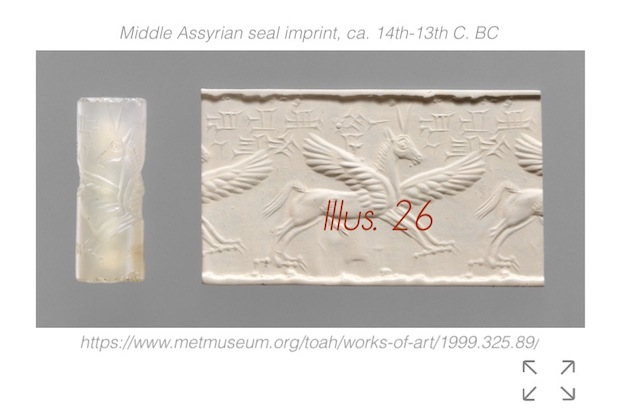
A comparison of Mycenaean objects with their (Middle) Assyrian parallels makes glaringly obvious the naturalism of the Greek (Mycenaean) pieces, and the stiffness of the Assyrian ones and confirms the proposition of the Met Museum author. The stiff unnatural poses in Near-Eastern (ie Assyrian) examples cannot, with any seriousness, be claimed to have served as the inspiration for Mycenaean representational art.
Above, 3 Mycenaean signet ring imprints showing, from left to right, a lion killing a bull; a warrior killing a lion; and a boar’s tusk wearing sphinx recoiling from an attack by a warrior; all published by Arthur Evans. http://digi.ub.uni-heidelberg.de
Below, 2 Middle Assyrian seal imprints showing a lion unnaturally “wrestling” a bull by its horns; a stiffly posed anthropomorphised griffin attacking a griffin. https://www.themorgan.org |
LINE OF TRANSMISSION
That Greeks partook in (neo) Assyria’s bloody wars of genocide is readily evident (illus 32 & 33). It is no doubt the means by which the attributes of the terrifying Anzu, and quite likely the Hurrian\Urartian models on which Assyrian ideas were based, were added to the Mycenaean griffin that turned it into the Classical Greek griffin. Intermediate period Greek “griffins” that do not have avian heads, and with open, fanged mouths, much like Anzu, evidence the point (illus. 25b).
| Above left, Greek Iron Age armour from Argos (found in a warrior-grave at Argos and assigned to ca. 740-700 BC), is seen in an Assyrian relief (above right) which is claimed to show Assyrians impaling their Judean victims. No such armour has ever been found in the Near East, though several examples have been found in Greece. Greeks are not supposed to be in Assyria. The Assyrian relief is from the ceremonial chamber of southwest palace at Nineveh, "depict[ing] key moments in the conquest of the Judean stronghold of Lachish by the Assyrian king Sennacherib in 701 BC." p. 71 Time-Life, Lost Civilizations series: Mesopotamia; the mighty kings. British Museum |
WIKIPEDIA 2018-2020
The Wikipedia eventually removed the composite winged-limbed-snake-guard (depicted on the "libation vase of Gudea") it had claimed was a griffin. Now the Wikipedia article uses a quadrupedal Anzu-like composite holding down ibex (much like Anzu is depicted holding ibex around 2000 years earlier) and misclassifies this as a “griffin”. A winged dog is not a griffin and is not consistent with the definition provided earlier on the page which states that griffins have “the head and wings of an eagle”. A dog’s head is not an eagle head.
| Above, screenshots of what are described as “griffins” on the current (at time of writing, 2020) Wikipedia page on griffins. |
DISCREDITED THEORIES STILL PROPOUNDED
A theory, described as “insightful” and claimed to have “solved the mystery of the griffin” — and which still commands academic respect — proposed by an American academic Adrienne Mayor, proclaims that griffins arose in the “Middle East between about 800 BC to AD 200”; and arose as an explanation to the discoveries of protoceratops fossils found by nomads in the Gobi desert, notwithstanding that griffins were depicted millennia before this. A comparison of protoceratops with the earliest representations of griffins (Elamite or Mycenaean) exposes this hypothesis as meritless. Though contradicted by evidence, this theory is nevertheless promoted by the American Museum of Natural History on its website. Meanwhile, Mayor herself tweeted an image of a Mycenaean-period griffin which she acknowledges is from the 13th century BC (illus. 39) … which needless to say is 500 years before her theory claims griffins arose. It looks nothing like a protoceratops. (Note: Mayor includes a line drawing alongside the signet ring in which the typical vegetal growth coming out of the Mycenaean griffin’s head is simplified and looks like what could be the ears of later Classical griffins)
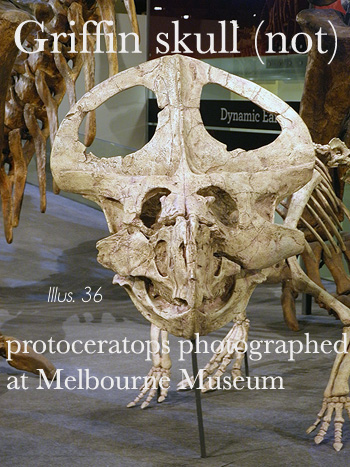 |
|
|
| Above left, my photograph of a (cast of a) protoceratops skeleton from the Melbourne (Australia) Museum. Above centre, a proto-Elamite griffin dating to ca. 3000 BC (from K. J. Roach’s thesis). Above right, a female Mycenaean griffin with engorged teats (https://arachne.uni-koeln.de/arachne , National Archaeological Museum Athens). |
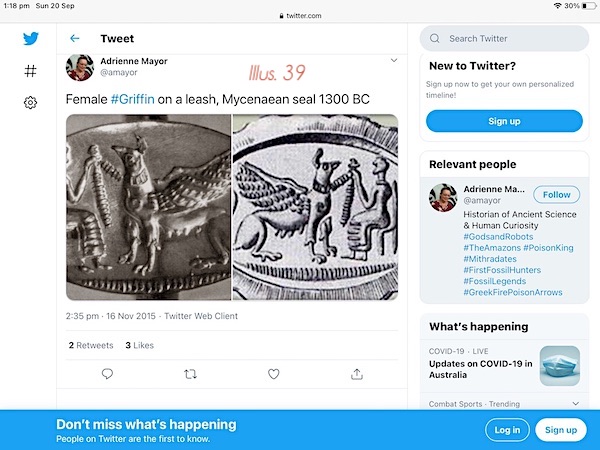
| Above, screenshot of Mayor’s tweet showing a Mycenaean griffin from ca. 1300 BC … which is far older than her proposal of griffins arising from around 800 BC. The griffin bears no resemblance to a protoceratops. |
THE PROBLEM WITH ACADEMIA
My original page primarily critiqued on-line misinformation about griffins but did not address misinformation from academia (that was available either online or in print). The Egyptian-origin of the “Minoan” griffin was a proposition advanced by Arthur Evans. It was always a proposition without merit. It remains however a proposition that is still advocated in academic circles. A Master’s Thesis for “Classics and Ancient Civilisations” submitted to, and published online by Lieden University (Netherlands), continues Evans’ Egyptian-griffin claim by redefining “griffins” so as to allow Egyptian composite beasts to be re-categorised as “griffins”. From that thesis:
“the features of a griffin, [are] a composite animal generally perceived in a Western view as: “a fabulous beast with the head and wings of an eagle and the body of a lion”. But, as Shih-Wei Hsu rightly points out and as will appear throughout this thesis, this definition is not suitable for Egyptian griffins.”
Only by the means of a redefinition can Horus as a Hieracosphinx, as well as other Egyptian composites which are not remotely griffin-like, be turned into griffins.
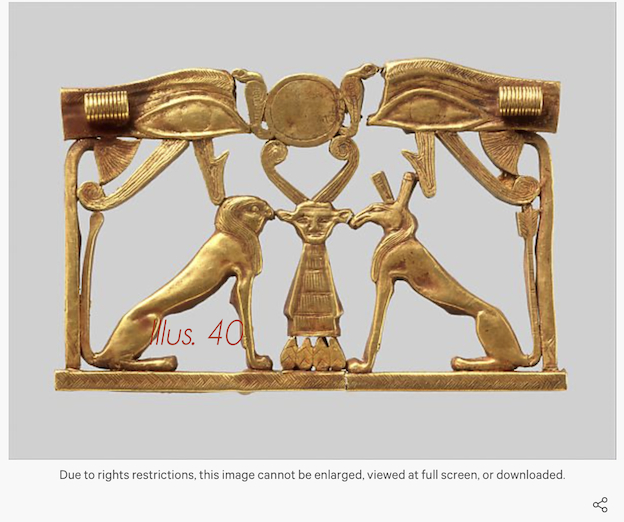
Above, posted on the Met Museum website: a “Pectoral with an Opposing Seth Animal and Hieracosphinx. Middle Kingdom, Dynasty 12 (ca. 1981–1802 B.C.)…Lender Johns Hopkins University Archaeological Museum for Eton College, Windsor, England.” “On the right is the god Seth, who can signify southern Egypt, while on the left is a hieracosphinx representing Horus, a deity here related to northern Egypt.” A line drawing of this same object which is known to depict Horus, appeared in a thesis submitted to Lieden University claiming it to show a griffin. (Image: https://www.metmuseum.org/art/collection/search/591225 )
Below, wall painting from Khnumhotep II’s tomb (dated to ca. 1922-1874 BC) showing a serval (or perhaps a cheetah) with a winged head emerging out of its back — which Arthur Evans had claimed was a “Cherub”. In an academic thesis posted by a Dutch University online, it is asserted as showing a griffin and the head, which is clearly that of a serval, is claimed to be a falcon head — despite its throat and ears being clearly visible. This thesis then goes on to cite Gerke, Der altägyptische Greif, to proclaim that the feline component is a jaguar! On the authority of an established academic, Gerke, jaguars, native to the Americas, appeared in Egyptian paintings nearly 3,500 years before they were known outside the Americas. |
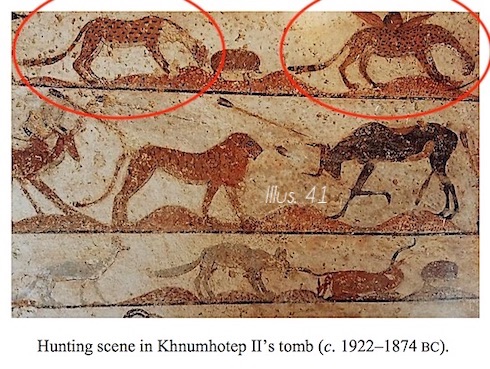
IMAGES AS SYMBOLS OF CONCEPTS
In drawing their conclusions academics such as Mayor and the Lieden University thesis author fail to appreciate how concepts are capable of being expressed using images in which each element is a symbol that is used to express an idea. Mayor, for instance, fails to appreciate that the griffin is a composite that intends to express a concept and believes it to instead be an attempt to make sense of fossils dug from the ground; while the Lieden University thesis author does not sufficiently appreciate the symbolism in the objects that she describes as griffins. It is quite obvious that a hieracosphinx is a symbolic representation of the god as a falcon; and the depiction of what would ordinarily be a feline is, because it includes a winged human head, a symbol of something more than an ordinary feline. It is the divinity either manifesting themselves as a feline, or a divinely-guided feline. In examples (that are admittedly a millennium later) from the Near East, Venus, the moon and sun — which are usually represented as objects in the heavens — are represented to express a similar idea of the divine. The human form, when added to them in later works, expresses the idea that the astral phenomena (sun, moon and Venus) are actually the gods. It is a similar kind of symbolism as was used by Homer in his expression form the Illiad, of “winged words” (ἔπεα πτερόεντα), in which ideas are imparted in the form of sounds; that is, ideas take wing as sound when spoken and are received by the listener. Conceptually the Elamite griffin, the Mycenaean griffin and the Hieracosphinx are related only in-so-far as they express concepts using images — yet each one expresses a completely different concept.
| Above left, kuduru showing Venus, moon and sun. Above right, Assyrian fragment showing Venus, sun and moon guided by divinities in human form.. |
What are presented as being griffins are not griffins. Horus as a Hieracosphinx guided by the divine which is represented by a winged human form depicted on a “magic wand” (below), is not a griffin.
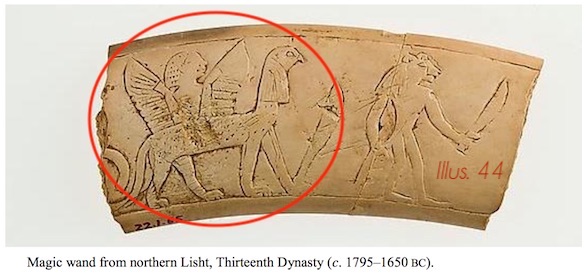
MY GRIFFIN PAGE PLAGIARISED ON A BLOG (2013 screenshot)
My griffin page was plagiarised by a Greek Macedonian nationalist blogger (see screenshot below). He altered my “the author stated” to “Some scientists claims” while keeping all the graphics; the order they appear in; and the notes appended to them, the same. For whatever reason the poster used my material to bolster his case for a Greek Macedonia. That page has since been taken down by Google.
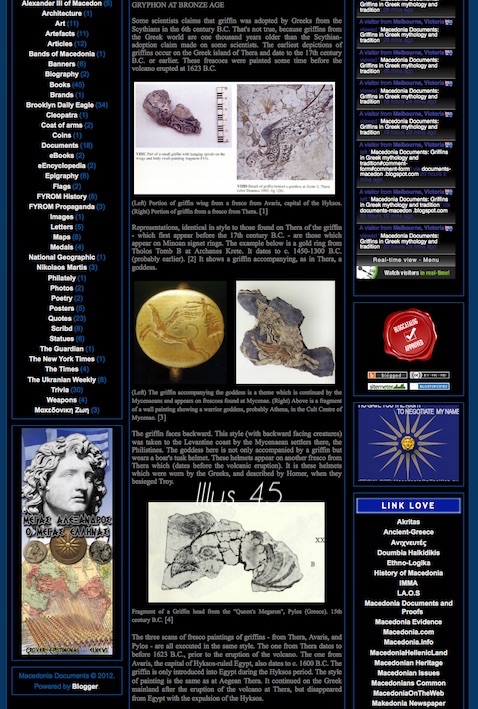
CONCLUSION
There is a considerable amount of revision that is necessary for the original page, of which only some of the elements that need revising being touched on here. Unfortunately the revision — which is extensive — will not be posted on the internet because of the actions of some readers who shamelessly use material created by others to peddle it as their own. The material I had presented was always for the curious to launch their own enquiries, not fodder to be plagiarised. Demetrios Vakras September-December 2020.
|
